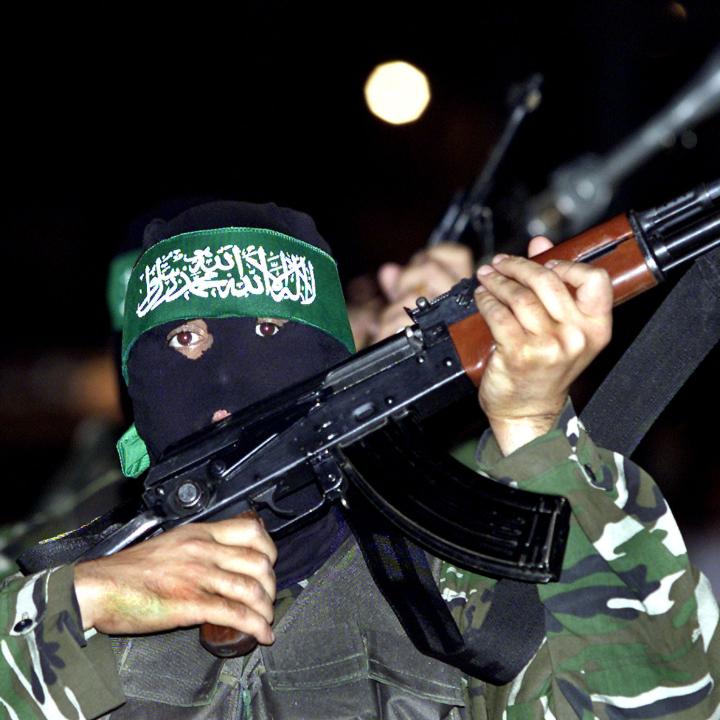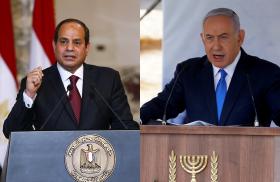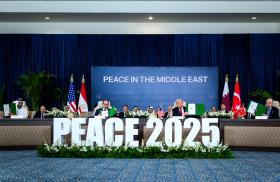
- Policy Analysis
- PolicyWatch 4040
Deporting Hamas’s Top Brass: A Path to Ending the War in Gaza

Although Hamas is still unwilling to discuss full disarmament, granting safe passage to hundreds of commanders could have similar effects on the ground while enabling the parties to end the fighting and reach a viable “day after” agreement.
Recently, several senior Hamas figures indicated to U.S. envoys via intermediaries in Qatar that the group may be willing to accept limited deportations of its military commanders and certain other operatives from the Gaza Strip. The same figures also conveyed that Hamas may be ready to discuss a longer-term ceasefire, postwar “security arrangements,” and the handover of administrative tasks to another governing body, though they declined to use the term “disarmament.”
If the Hamas Political Bureau embraces this potential new negotiating stance, it may represent the best route out of the current stalemate, paving the way toward a U.S.-brokered agreement on ending the war and releasing the remaining hostages. Of course, it is far from certain that the messages received from a handful of leaders—based in Qatar, no less—will be accepted as policy by the entire organization, especially the affected members on the ground in Gaza. So far, the proposal mainly reflects growing awareness on Hamas’s part that meaningful concessions are required if ending the fighting is truly their top priority. As they are keenly aware, Israel’s “Gideon’s Chariots” operation has been applying heavy pressure this week, killing all of the group’s top commanders in southern Gaza and dozens of other operatives. They also understand that even if Prime Minister Binyamin Netanyahu is willing to consider an extended ceasefire in exchange for the return of all hostages (living and dead), his security cabinet will demand more than that, since key members remain sworn to the objective of crushing Hamas’s military forces and removing it from power.
Notably, deportation and disarmament were raised frequently during the many months of talks conducted through Egyptian and Qatari mediators. Yet Khalil al-Hayya and his Hamas negotiating team adamantly rejected both ideas, and Arab officials evidently did not pressure them enough to change their minds. It is unknown if these issues were raised in the group’s more recent direct channel with the Trump administration. In any case, at least part of the Hamas leadership appears ready to soften their stand on exiling commanders from the group’s military “wing,” the Izz al-Din al-Qassam Brigades, but less ready to commit to any plans for disarmament. According to Palestinian sources, the latest draft agreement submitted by the mediators with Washington’s blessing calls on Hamas to put its heavy weapons in storage—a process that would be supervised by the Palestinian Authority and observers from countries that would be assisting the new governing body in Gaza.
Deportation Precedents
Palestinian armed groups have accepted the idea of expulsion in the past. The most dramatic example was Yasser Arafat’s August 1982 departure from Beirut to Tunis with 8,500 Palestine Liberation Organization fighters following a deal brokered by U.S. envoy Philip Habib. Arafat and some of his cohorts soon infiltrated back into north Lebanon—only to accept another expulsion to Tunis in December 1983 while under fire from pro-Syrian proxies (this time he exited via Tripoli with 4,700 fighters).
Numerous other voluntary deportations occurred over the next few decades. In May 2002, thirteen Palestinian gunmen were expelled to Cyprus after barricading themselves inside Bethlehem’s Church of the Nativity with Christian hostages for forty days. This arrangement was mediated by the Archbishop of Canterbury as part of a deal to lift Israel’s siege of the church.
In other cases, dozens of high- and mid-level Hamas operatives convicted of terrorist crimes by Israeli courts were deported with the consent of the group’s leadership in exchange for freeing Israeli hostages. Many of those exiled later became key figures in Hamas and Palestinian Islamic Jihad headquarters in Doha, Beirut, Istanbul, Damascus, and even back in Gaza, where they sought to orchestrate attacks from the West Bank.
During the current war, earlier rounds of negotiations saw Hamas consent to the expulsion of certain prisoners whom Israel deemed too dangerous to go back to their homes in the West Bank. The group also agreed to the principle that once the rest of the hostages are released, dozens more Hamas prisoners would be exiled, including Ibrahim Hamed and Abbas al-Sayed, the former commanders of the group’s underground networks in the West Bank.
Backroom Friction
Besides offering a pathway to a settlement, the reports of potential softening in Hamas positions reflect the rapidly changing balance of power with the group’s top echelons. The main feature of this ongoing backroom struggle is the rise of individuals who were removed from the decisionmaking process for years and thus were not involved in the preparations for the October 7 attack on Israel. In recent months, some Hamas elements have intensified their criticism of that assault as premature and insufficiently coordinated with Iran and Lebanese Hezbollah, though this internal dissension rarely leaks into the public domain.
Moreover, the group now lacks a clear hierarchy following the deaths of so many senior figures, including Political Bureau chairman Ismail Haniyeh, his deputy Saleh al-Arouri, and the two main architects of October 7, Muhammad Deif and Yahya al-Sinwar. Within this vacuum, Hamas members who were sidelined in the past have seized influential roles in shaping outside negotiations—most notably financial chief Muhammad Ismail Darwish and Nizar Awadallah, who previously contended with Sinwar for the top post in Gaza (though both men still shy away from the limelight).
Finding the Right “Day After” Scenario
Whether officially or through “non-papers,” several Arab governments have proposed blueprints for postwar Gaza, including Saudi Arabia, the United Arab Emirates, Egypt, Jordan, and the Palestinian Authority. In each case, officials have made it known that they envision disarming Hamas and its terrorist allies to allow for the establishment of a technocratic committee that can run the Strip and facilitate the flow of major reconstruction funding. So far, however, most Arab governments have refrained from publicly calling on Hamas to hand over its weapons. PA President Mahmoud Abbas is the only one to repeatedly state that no weapons should be tolerated in the Palestinian territories outside of PA security agencies.
For its part, Hamas has been fairly eager to relinquish its civil responsibilities in Gaza while avoiding discussions of disarmament—a clear signal that it intends to copy Hezbollah’s model of remaining the strongest military force on the ground while leaving governance and service provision to others. At the same time, the group has reached the point where it can no longer simply ignore the pressure to explore mechanisms for disarmament, since this is Israel’s top priority and a growing back-channel demand by U.S.-backed Arab governments. In response to this dilemma, Hamas is evidently looking for ways to retain as much of its military arsenal as possible while counting on the weakness of any future administration in Gaza to ensure it can still exert control on the ground. Even if Arab states fulfill their tacit promise to send a few security battalions to police Gaza under a post-Hamas administration, none of them is prepared to undertake the difficult task of dismantling the group’s military infrastructure.
This is why deporting Hamas’s top brass is such a promising alternative. Depending on the included ranks agreed to by negotiators, around 1,000-3,000 military commanders could be offered safe passage out of Gaza. If they accept, the group’s ability to function would be severely compromised. Replenishing its arsenal of rockets and antitank weapons would become extremely complicated, and restoring large parts of the destroyed tunnel system would likely be impossible once the “brains” of the operation were gone, not to mention the necessary engineering equipment and funding.
Commanders might also be more amenable to leaving given growing local pressures to end the war as soon as possible. Although the spate of public protests denouncing Hamas was recently quashed following street executions of “collaborators,” the group has apparently instructed its military operatives to keep a low profile and stay away from markets and aid distribution points—presumably to disguise their participation in Gaza’s flourishing black market economy, where exorbitant prices are charged for the distribution of humanitarian goods. Indeed, local commanders likely realize that taking care of the population’s needs is way beyond their capabilities. They also know they are unable to stop the Israeli military from maneuvering deep into Gaza, and after spending months hiding in tunnels and losing many fellow combatants, they no doubt feel exposed to Israeli targeting. In short, it is safe to assume that many of them would be happy to leave.
One crucial question remains unresolved: where exactly would these Hamas commanders go? Egypt, Jordan, and the Gulf states would never agree to take them in, while past hosts Syria and Lebanon are no longer willing to accept such guests amid their ongoing political transitions. That leaves countries like Iran, Algeria, Qatar, Libya, Tunisia, Turkey, or even faraway Malaysia, though they may not relish the idea of importing large numbers of Hamas terrorists either. In any case, finding one or several host countries willing to absorb hundreds of Hamas operatives is essential to implementing this formula for ending the war.
Other major obstacles include formulating the mechanisms of the deportation process, deciding the identities and final numbers of members to be exiled, determining the status of their families, and addressing Hamas’s demand for guarantees that Israel will not pursue them. These issues alone may require long negotiations, in addition to the major work needed to shape a multiparty system for the “day after.” And if history is any indicator, Israel and its partners will need to have a solid plan in place to prevent the return of these exiles en masse. As in the past, deportees will be asked to sign documents committing not to attempt re-infiltration, and the new committee in charge of Gaza will be asked to monitor this issue closely. More important, Israel and Egypt’s existing regime of crossing-point inspections and sea patrols would make reentry very difficult.
Israel’s current military campaign in Gaza was designed with significant pauses in mind to allow for phased implementation of a deal. Thus, U.S. officials could enlist Arab governments to publicly support deportation arrangements even amid the new fighting, pressuring all parties to speed up the bargaining process. If successful, such efforts could soon produce a framework of agreed principles and a viable ceasefire, enabling the parties to launch the initial stages of a broader postwar deal.
Ehud Yaari is The Washington Institute’s Lafer International Fellow and a Middle East commentator for Israel’s Channel 12 television.



